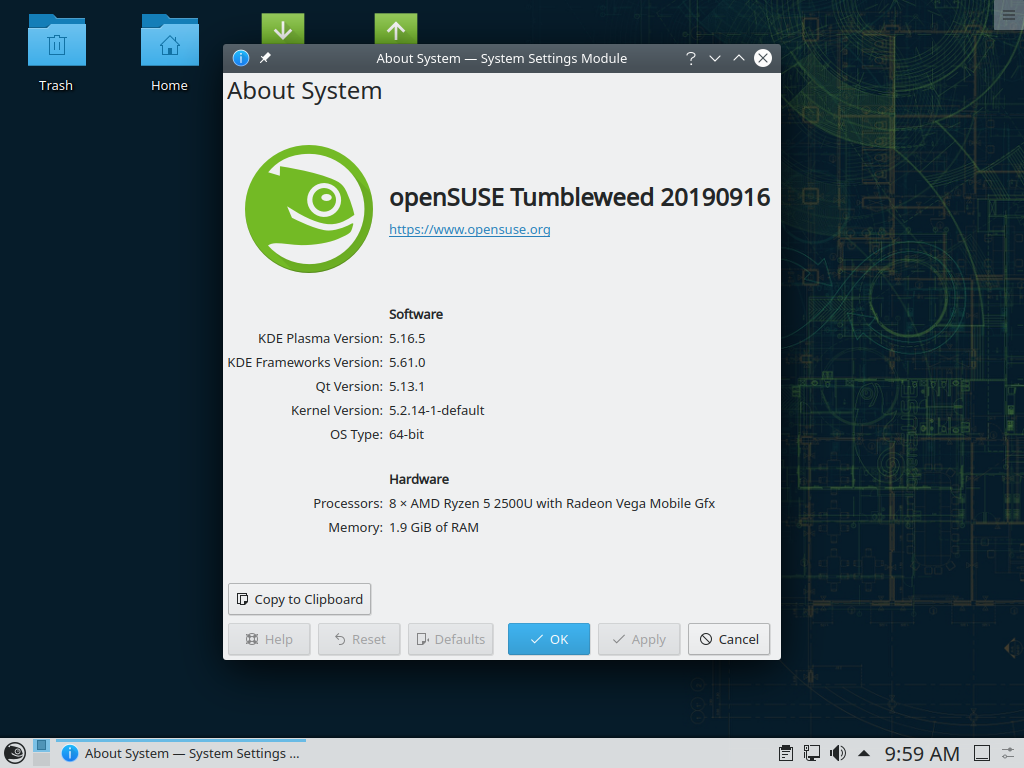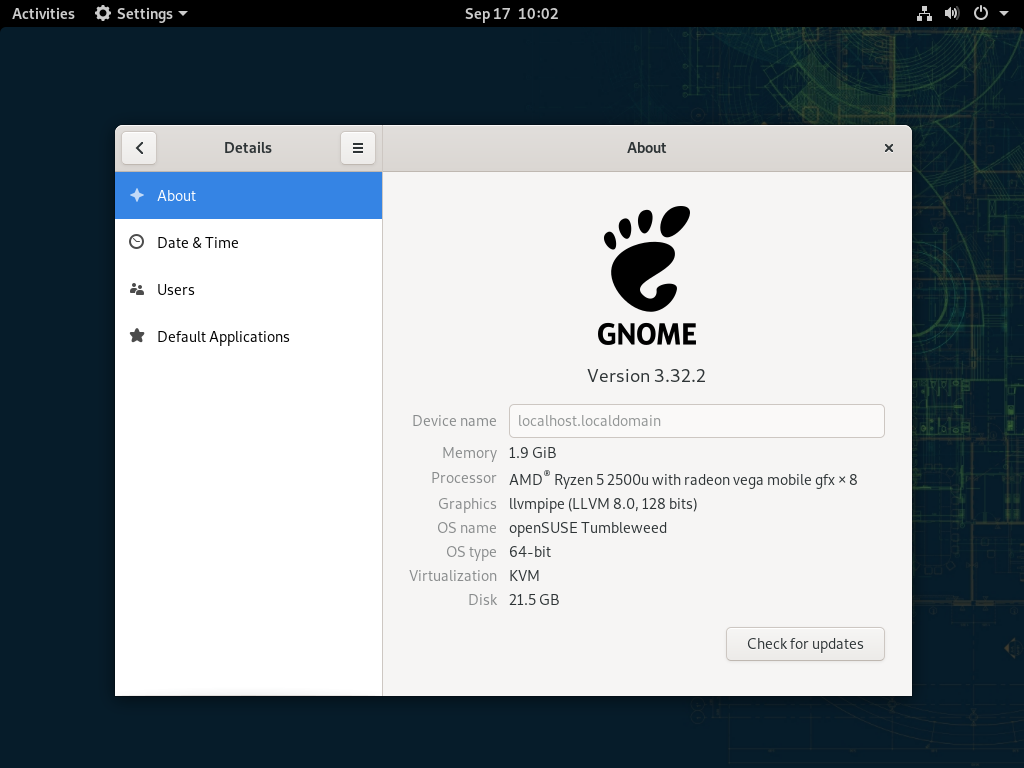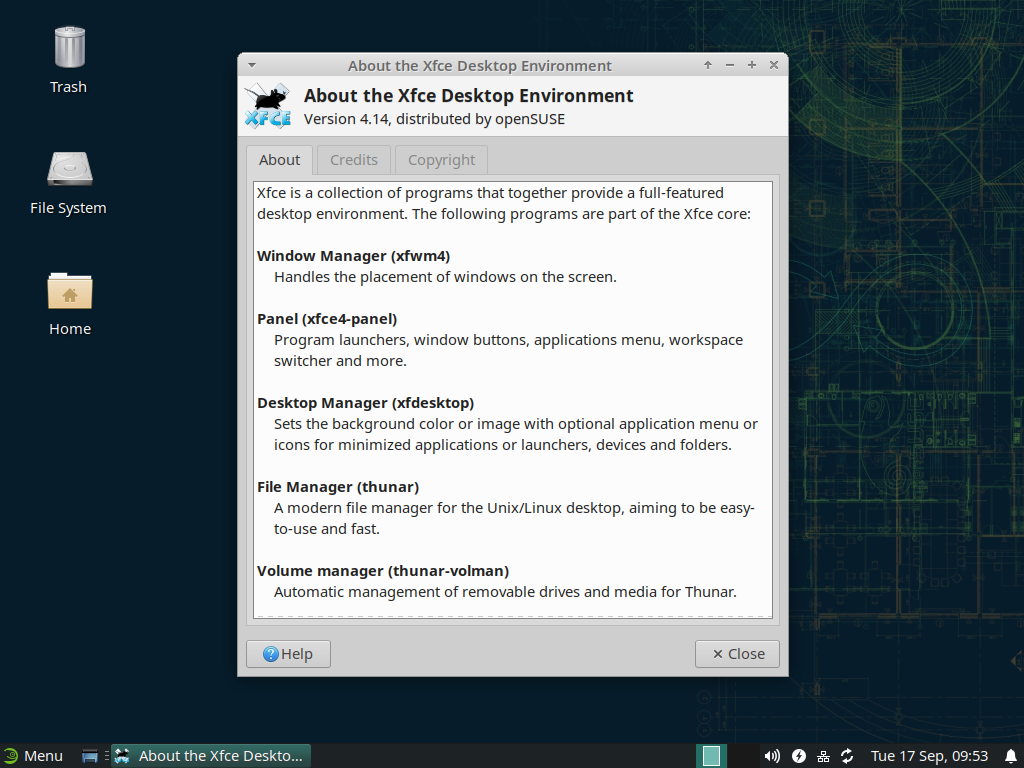- openSUSE Desktop Distributions
- Tumbleweed
- Many desktops, three by default
- Getting software couldn’t be easier
- Everything is transparent
- Free software? Your choice
- Welcoming contributions
- openSUSE Desktop Distributions
- Tumbleweed
- Many desktops, three by default
- Getting software couldn’t be easier
- Everything is transparent
- Free software? Your choice
- Welcoming contributions
- openSUSE Leap 15.3
- A brand new way of building openSUSE and a new type of a hybrid Linux distribution
- Choosing Which Media to Download
- Easy Ways to Switch to openSUSE Leap
- Documentation
- System Requirements
- Verify Your Download Before Use
- openSUSE Leap 15.3
- A brand new way of building openSUSE and a new type of a hybrid Linux distribution
- Live-образ
- Выбор носителя для загрузки
- Как перейти на openSUSE Leap
- Документация
- Рекомендуемые системные требования
- Проверка загруженного образа перед использованием
- Portal:Leap
- Добро пожаловать на портал Leap Править
- Основные возможности Править
openSUSE Desktop Distributions
The two distributions to rule them all (now in green!)
Tumbleweed
For Developers, openSUSE Contributors, Gamers and Linux/FOSS Enthusiasts
Rolling release with the latest packages provided by the openSUSE Project.
For Sysadmins, Enterprise Developers, and вЂRegular’ Desktop Users
Regular release with the benefits of both enterprise-grade engineering and community-developed innovation.
KDE Plasma 5
GNOME 3
Xfce Desktop 4
Many desktops, three by default
The openSUSE contribution process empowers desktop development for everybody, so you have the choice to pick your favourite one in the installer. We actively feature three desktop environments, and offer even more in the expanded software view within the installer.
Getting software couldn’t be easier
Between us, having to go through every website to get all the software you might need is a lot of work. The online software center makes this way easier, by incorporating software from a plethora of sources in one place.
Everything is transparent
From start to finish, every package which goes into the distributions has all of its sources and build scripts openly visible for everyone to see. Doubtful of a source? Just check it out on the build service.
Free software? Your choice
Packages in the distributions are divided into free and non-free repositories. Don’t want to use non-free packages? You can easily disable the non-free repository. It’s your choice, not ours.
Welcoming contributions
We try our best to please the community, and we can only make this happen when the community is vocal about what they need. That’s why we ensure contributing is as easy as possible.
YaST, the best choice for the power user
One of the greatest system configuration tools helps you, the user, to setup every single aspect of your system. You no longer need to go through a plethora of configuration scripts or enter dubious commands to get the system setup as you need it.
Источник
openSUSE Desktop Distributions
The two distributions to rule them all (now in green!)
Tumbleweed
For Developers, openSUSE Contributors, Gamers and Linux/FOSS Enthusiasts
Rolling release with the latest packages provided by the openSUSE Project.
For Sysadmins, Enterprise Developers, and ‘Regular’ Desktop Users
Regular release with the benefits of both enterprise-grade engineering and community-developed innovation.
KDE Plasma 5
GNOME 3
Xfce Desktop 4
Many desktops, three by default
The openSUSE contribution process empowers desktop development for everybody, so you have the choice to pick your favourite one in the installer. We actively feature three desktop environments, and offer even more in the expanded software view within the installer.
Getting software couldn’t be easier
Between us, having to go through every website to get all the software you might need is a lot of work. The online software center makes this way easier, by incorporating software from a plethora of sources in one place.
Everything is transparent
From start to finish, every package which goes into the distributions has all of its sources and build scripts openly visible for everyone to see. Doubtful of a source? Just check it out on the build service.
Free software? Your choice
Packages in the distributions are divided into free and non-free repositories. Don’t want to use non-free packages? You can easily disable the non-free repository. It’s your choice, not ours.
Welcoming contributions
We try our best to please the community, and we can only make this happen when the community is vocal about what they need. That’s why we ensure contributing is as easy as possible.
YaST, the best choice for the power user
One of the greatest system configuration tools helps you, the user, to setup every single aspect of your system. You no longer need to go through a plethora of configuration scripts or enter dubious commands to get the system setup as you need it.
Источник
openSUSE Leap 15.3
A brand new way of building openSUSE and a new type of a hybrid Linux distribution
Leap uses source from SUSE Linux Enterprise (SLE), which gives Leap a level of stability unmatched by other Linux distributions, and combines that with community developments to give users, developers and sysadmins the best stable Linux experience available.
Intel or AMD 64-bit desktops, laptops, and servers (x86_64)
Offline Image (4.4 GiB)
Network Image (146.0 MiB)
UEFI Arm 64-bit servers, desktops, laptops and boards (aarch64)
Offline Image (4.1 GiB)
Network Image (167.2 MiB)
PowerPC servers, not big-endian (ppc64le)
Offline Image (4.1 GiB)
Network Image (133.9 MiB)
IBM Z and LinuxONE (s390x)
Offline Image (1.7 GiB)
Network Image (104.6 MiB)
Intel or AMD 64-bit desktops, laptops, and servers (x86_64)
KVM and XEN (228.8 MiB)
MS HyperV (141.4 MiB)
VMware (142.4 MiB)
OpenStack-Cloud (217.3 MiB)
Intel or AMD 64-bit desktops, laptops, and servers (x86_64)
GNOME LiveCD (857.4 MiB)
KDE LiveCD (927.7 MiB)
Xfce LiveCD (906.9 MiB)
Rescue LiveCD (617.1 MiB)
UEFI Arm 64-bit servers, desktops, laptops and boards (aarch64)
GNOME LiveCD (826.2 MiB)
KDE LiveCD (897.1 MiB)
Xfce LiveCD (878.2 MiB)
Rescue LiveCD (597.1 MiB)
Choosing Which Media to Download
The Offline Image is typically recommended as it contains most of the packages available in the distribution and does not require a network connection during the installation.
The Network Image is recommended for users who have limited bandwidth on their internet connections, as it will only download the packages they choose to install, which is likely to be significantly less than 4.7GB.
Easy Ways to Switch to openSUSE Leap
If you’re already running openSUSE you can upgrade by booting from the DVD/USB and choosing upgrade, or carry out an вЂOnline Upgrade’ in a few commands. Online Upgrade Instructions.
| From an older version or other Linux distro | From Windows | From OS X |
|---|---|---|
| How to burn a DVD on Linux. | How to burn a DVD on Windows. | How to burn a DVD on OS X. |
| How to create a bootable USB stick on Linux. | How to create a Bootable USB stick on Windows. | How to create a bootable USB stick on OS X. |
Documentation
System Requirements
- 2 Ghz dual core processor or better
- 2GB physical RAM + additional memory for your workload
- Over 40GB of free hard drive space
- Either a DVD drive or USB port for the installation media
- Internet access is helpful, and required for the Network Installer
Verify Your Download Before Use
Many applications can verify the checksum of a download. To verify your download can be important as it verifies you really have got the ISO file you wanted to download and not some broken version.
For each ISO, we offer a checksum file with the corresponding SHA256 sum.
For extra security, you can use GPG to verify who signed those .sha256 files.
For more help verifying your download please read Checksums Help
Источник
openSUSE Leap 15.3
A brand new way of building openSUSE and a new type of a hybrid Linux distribution
Leap uses source from SUSE Linux Enterprise (SLE), which gives Leap a level of stability unmatched by other Linux distributions, and combines that with community developments to give users, developers and sysadmins the best stable Linux experience available.
Intel or AMD 64-bit desktops, laptops, and servers (x86_64)
Образ без сети (4.4 GiB)
Образ для установки по сети (146.0 MiB)
UEFI Arm 64-bit servers, desktops, laptops and boards (aarch64)
Образ без сети (4.1 GiB)
Образ для установки по сети (167.2 MiB)
PowerPC servers, not big-endian (ppc64le)
Образ без сети (4.1 GiB)
Образ для установки по сети (133.9 MiB)
IBM Z and LinuxONE (s390x)
Образ без сети (1.7 GiB)
Образ для установки по сети (104.6 MiB)
Intel or AMD 64-bit desktops, laptops, and servers (x86_64)
KVM и XEN (228.8 MiB)
MS HyperV (141.4 MiB)
VMware (142.4 MiB)
OpenStack-Cloud (217.3 MiB)
Live-образ
Intel or AMD 64-bit desktops, laptops, and servers (x86_64)
LiveCD GNOME (857.4 MiB)
LiveCD KDE (927.7 MiB)
LiveCD Xfce (906.9 MiB)
LiveCD восстановления (617.1 MiB)
UEFI Arm 64-bit servers, desktops, laptops and boards (aarch64)
LiveCD GNOME (826.2 MiB)
LiveCD KDE (897.1 MiB)
LiveCD Xfce (878.2 MiB)
LiveCD восстановления (597.1 MiB)
Выбор носителя для загрузки
The Offline Image is typically recommended as it contains most of the packages available in the distribution and does not require a network connection during the installation.
The Network Image is recommended for users who have limited bandwidth on their internet connections, as it will only download the packages they choose to install, which is likely to be significantly less than 4.7GB.
Как перейти на openSUSE Leap
If you’re already running openSUSE you can upgrade by booting from the DVD/USB and choosing upgrade, or carry out an ‘Online Upgrade’ in a few commands. Online Upgrade Instructions.
| С более старой версии или другого дистрибутива Linux | С Windows | С OS X |
|---|---|---|
| Как записать DVD в Linux. | Как записать DVD в Windows. | Как записать DVD в OS X. |
| Как создать загружаемый USB-носитель в Linux. | Как создать загружаемый USB-носитель в Windows. | Как создать загружаемый USB-носитель в OS X. |
Документация
Рекомендуемые системные требования
- 2 Ghz dual core processor or better
- 2GB physical RAM + additional memory for your workload
- Over 40GB of free hard drive space
- Either a DVD drive or USB port for the installation media
- Internet access is helpful, and required for the Network Installer
Проверка загруженного образа перед использованием
Many applications can verify the checksum of a download. To verify your download can be important as it verifies you really have got the ISO file you wanted to download and not some broken version.
For each ISO, we offer a checksum file with the corresponding SHA256 sum.
For extra security, you can use GPG to verify who signed those .sha256 files.
For more help verifying your download please read Справка по контрольным суммам
Источник
Portal:Leap
Добро пожаловать на портал Leap Править
openSUSE Leap — это название нового подхода к созданию регулярных выпусков Linux-дистрибутива openSUSE.
Для основы openSUSE Leap был взят SUSE Linux Enterprise. Первый прыжок (Leap) запланирован на ноябрь 2015 года.
Для получения дополнительной информации о разработке Leap обратитесь к следующей странице openSUSE:Leap.
Основные возможности Править
 | Эта статья содержит фрагменты на иностранном языке. Вы можете помочь переведя её до конца. (cм. руководство по переводу) |
Было проделано много работы для обеспечения будущего openSUSE. Выбирая SLE (SUSE Linux Enterprise) в качестве основы для openSUSE мы получаем ядро openSUSE которое будет поддерживаться инженерами SUSE. Это означает, что оно будет получать исправления и обновления безопасности из SLE.
Проект openSUSE может заменить и добавить кусочки программного обеспечения, которые добровольцы хотят и готовы поддерживать.
openSUSE Leap will also complement Tumbleweed better. When there was one openSUSE, it was torn between those who wanted newer software and those who wanted a stable system. Tumbleweed caters to those who want newer software, which allows the regular release to do an even better job of providing a highly stable system.
Contribute to Leap
The Tumbleweed page explains whether you’d want to choose Tumbleweed or the current openSUSE 13.2. Much of this will hold true for openSUSE Leap when it becomes the regular release.
Q. Will openSUSE Leap work with newer computers?
Yes — the first release of openSUSE Leap, openSUSE Leap 42.1, will ship with version 4.1 of the Linux Kernel which should provide very modern hardware support
Q. Will the Linux kernel/GNOME/KDE/something else be older than the version is in 13.2?
No — The first development milestone of openSUSE Leap 42.1 contains KDE Plasma 5.3 and GNOME 3.16 (NOTE: This may change before release, but is likely to increase, not decrease)
Q. Will openSUSE Leap work with older computers?
Возможно — openSUSE Leap будет поддерживать только 64-битную архитектуру и не сможет работать на старом оборудовании не поддерживающем выполнение набора инструкций x86_64.
Источник








